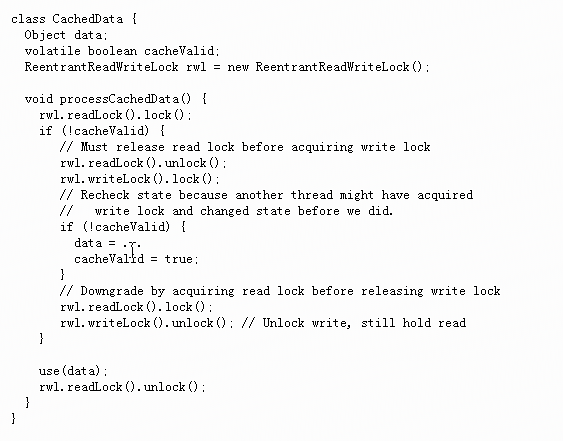java5读写锁技术的妙用
2018-01-17 00:00
141 查看
一、概述
读写锁:分为读锁和写锁,多个读锁不互斥,读锁与写锁互斥,这是由jvm自己控制的,你只要上好相应的锁即可。如果你的代码只读数据,可以很多人同时读,但不能同时写,那就上读锁;如果你的代码修改数据,只能有一个人在写,且不能同时读取,那就上写锁。总之,读的时候上读锁,写的时候上写锁!二、代码描述
1、ReadWriteLockTest.java
/**
* @Title: ReadWriteLockTest.java
* @Package com.lh.threadtest.t10
* @Description: TODO
* @author Liu
* @date 2018年1月17日 下午5:17:47
* @version V1.0
*/
package com.lh.threadtest.t10;
import java.util.Random;
import java.util.concurrent.locks.ReadWriteLock;
import java.util.concurrent.locks.ReentrantReadWriteLock;
/**
* @ClassName: ReadWriteLockTest
* @Description: TODO
* @author Liu
* @date 2018年1月17日 下午5:17:47
*
*/
public class ReadWriteLockTest {
public static void main(String[] args) {
final Queue3 q3 = new Queue3();
for(int i=0;i<3;i++)
{
new Thread(){
public void run(){
while(true){
q3.get();
}
}
}.start();
}
for(int i=0;i<3;i++)
{
new Thread(){
public void run(){
while(true){
q3.put(new Random().nextInt(10000));
}
}
}.start();
}
}
}
class Queue3{
private Object data = null;//共享数据,只能有一个线程能写该数据,但可以有多个线程同时读该数据。
private ReadWriteLock rwl = new ReentrantReadWriteLock();
public void get(){
rwl.readLock().lock();
try {
System.out.println(Thread.currentThread().getName() + " be ready to read data!");
Thread.sleep((long)(Math.random()*1000));
System.out.println(Thread.currentThread().getName() + "have read data :" + data);
} catch (InterruptedException e) {
e.printStackTrace();
}finally {
rwl.readLock().unlock();
}
}
public void put(Object data){
rwl.writeLock().lock();
try {
System.out.println(Thread.currentThread().getName() + " be ready to write data!");
Thread.sleep((long)(Math.random()*1000));
this.data = data;
System.out.println(Thread.currentThread().getName() + " have write data: " + data);
} catch (InterruptedException e) {
e.printStackTrace();
}finally {
rwl.writeLock().unlock();
}
}
}2、CachedDB.java
/**
* @Title: CachedDB.java
* @Package com.lh.threadtest.t10
* @Description: TODO
* @author Liu
* @date 2018年1月17日 下午6:12:33
* @version V1.0
*/
package com.lh.threadtest.t10;
import java.util.HashMap;
import java.util.Map;
import java.util.Objects;
import java.util.concurrent.locks.ReadWriteLock;
import java.util.concurrent.locks.ReentrantReadWriteLock;
/**
* @ClassName: CachedDB
* @Description: TODO
* @author Liu
* @date 2018年1月17日 下午6:12:33
*
*/
public class CachedDB {
/***
* @Title: main
* @Description: TODO
* @param @param args
* @return void
* @throws
*/
public static void main(String[] args) {
Business business = new Business();
for(int i = 1; i <= 3; i++){
for(int j = 1; j <= 3; j++){
final int target = j;
new Thread(new Runnable() {
@Override
public void run() {
System.out.println(Thread.currentThread().getName() + " val: " + business.getAndSet(target + ""));
}
},"threadName-" + target).start();
}
}
}
}
class Business{
private static Map<String, Integer> cachedMap = new HashMap<>();
private ReadWriteLock rwl = new ReentrantReadWriteLock();
static{
cachedMap.put("xiaofang", 1);
cachedMap.put("xiaobai", 2);
cachedMap.put("xiaomei", 3);
}
public Integer getAndSet(String name){
rwl.readLock().lock();
Integer target = null;
try {
target = cachedMap.get(name);
if(Objects.isNull(target)){
rwl.readLock().unlock();
rwl.writeLock().lock();
try {
if(Objects.isNull(target)){
target = name.equals("1") ? 10 : (name.equals("2") ? 100 : 1000);//去查询数据库
cachedMap.put(name, target);
}
} finally {
rwl.writeLock().unlock();
}
rwl.readLock().lock();
//use...
}
} finally {
rwl.readLock().unlock();
}
return target;
}
}三、读写锁API缓存demo

参考资料
1、java中ReentrantReadWriteLock读写锁的使用2、java并发编程系列之ReadWriteLock读写锁的使用
相关文章推荐
- 多线程12_张孝祥 java5读写锁技术的妙用
- java5读写锁技术的妙用(十二)
- Java5并发库之锁(二)——读写锁技术的妙用
- 12.Java5读写锁技术的妙用
- (9)java5的线程【锁lock】与【读写锁_以及模拟缓存(妙用)】技术
- 【Java多线程与并发库】10.java5的线程锁(读写锁)技术
- 11-java5读写锁技术
- (9)java5的线程【锁lock】与【读写锁_以及模拟缓存(妙用)】技术
- 【Java多线程与并发库】10.java5的线程锁(读写锁)技术
- 【张孝祥并发课程笔记】11:java5读写锁技术
- 从程序员到CTO的Java技术路线图
- Java技术简介及Tomcat部署
- 总结一些考察初级Java程序员技术能力的要点(转)
- JAVA技术实现上传下载文件到FTP服务器(完整)
- Java同步技术(九)
- NHibernate composite-id class must override Equals() 解决办法 分类: 技术心得(C#与JAVA) 2013-01-23 15:20 1289人阅
- 总结Java常用到的六个加密技术和代码
- java应用技术2
- JavaNativeAccess-----------一种方便的调用本地方法的技术
